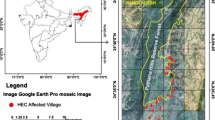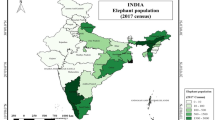Abstract
This study revealed that a total of 422 crop fields were visited by elephants across the six forest ranges of Coimbatore Forest Division during the study period. The number of crop fields which are affected by elephants was high in Boluvampatti range (116) followed by Coimbatore (107), PN Palayam (105), Mettupalayam (64) and Sirumugai (25). Very less number of affected crop fields was recorded in Karamadai range (5). The highest number of crop fields was affected in 0–0.5 km category from forest boundary in five forest ranges, i.e. Coimbatore, PN Palayam, Mettupalayam, Sirumugai and Karamadai. On the contrary, in Boluvampatti, the highest number of crop fields was affected in 0.5–1 km category. Frequency of crop fields affected in different distance categories from forest boundary (0–0.5 km, 0.5–1 km, 1–1.5 km, 1.5–2 km, 2–2.5 km) and within each forest range was significant (F = 5.98, P = 0.002). Frequency of crop fields affected in different distance categories from forest boundary (0–0.5 km, 0.5–1 km, 1–1.5 km, 1.5–2 km and 2–2.5 km) versus between forest ranges was also significant (F = 5.36, P = 0.002). As overall in Coimbatore Forest Division, crop fields located close to forest (0–0.5 km) were highly (35.55 %) affected by elephant visits. An overall intensity of elephant visits into the crop fields revealed that low intensity was traced in 40% of crop fields followed by medium (38%), and high intensity was noticed in 22 % of the crop fields. Statistical test revealed that frequency of crop fields affected in different distance categories (0–0.5 km, 0.5–1 km, 1–1.5 km,1.5–2 km, 2–2.5 km and 2.5–3 km) from forest and within various intensities of elephant visits (1–10, 11–20 and 21–30) was significant (F = 8.707, P = 0.002).
Access this chapter
Tax calculation will be finalised at checkout
Purchases are for personal use only
Similar content being viewed by others
References
Balasubramanian M, Baskaran N, Swaminathan S, Desai AA (1995) Crop raiding by Asian elephant (Elephas maximus) in the Nilgiri biosphere reserve, South India. In: Daniel JC, Datye HS (eds) A week with elephants. Bombay Natural History Society, Oxford University Press, Bombay, pp 350–367
Bell RHV (1984) The man-animal interface: an assessment of crop damage and wildlife control. In: Bell RHV, McShane-Caluzi (eds) Conservation and wildlife management in Africa. US Peace Corps Seminar, Malawi
Boominathan D, Mohanraj N, Aziz T, Desai A (2008) Management of the Asian elephant in the Nilgiris and Eastern Ghats: human-elephant conflict in Somwarpet Subdivision (Madikeri Forest Division). WWF AREAS
Daniel JC, Desai A, Kumar A, Sakthivel C (2008) Evaluating population enumeration methods and human elephant conflict mitigation methods in Mudumalai Tiger Reserve, Tamil Nadu, India. Bombay Natural History Society, Mumbai
Di Fonzo MMI (2007) Determining correlates of human-elephant conflict reports within fringe villages of Kaziranga National Park, Assam. Masters thesis, University of London and Imperial College, London
Douglas-Hamilton I, Krink T, Vollrath F (2005) Movements and corridors of African elephants in relation to protected areas. Naturwissenschaften 92(4):158–163
Fernando P, Kumar MA, Williams AC, Wickramanayake E, Aziz T, Singh SM (2008) Review of human-elephant conflict mitigation measures practiced in South Asia. WWF-World Wide Fund for Nature, AREAS Technical Support Document submitted to World Bank
Foley LS (2002) The influence of environmental factors and human activity on elephant distribution in Tarangire National Park, Tanzania. Masters thesis, International Institute for Geo-Information Science and Earth Observation, The Netherlands
Graham A (1973) The gardeners of Eden. George Allen & Unwin, London
Grant CC, Bengis R, Balfour D, Peel M, Davies-Mostert W, Killian H, Little R, Smit I, Garai MH, Anthony B, Hartley P (2008) Controlling the distribution of elephant. In: Mennell KG, Scholes RJ (eds.) Assessment of South African elephant management 2007, 246–277
Hoare RE (1999) Determinants of human-elephant conflict in a land-use mosaic. J Appl Ecol 36:689–700
Hoare RE (2001) A decision support system for managing human-elephant conflict situations in Africa. http://data.iucn.org/themes/ssc/sgs/afesg/hec/pdfs/hecdssen.pdf#page=1. Accessed 15 Jan 2008
IUCN (2006) Asian elephant range states meeting, 24–26 January 2006, Kuala Lumpur, Malaysia: Report. Switzerland
Johnsingh AJT, Joshua J (1994) Conserving Rajaji and Corbett National Parks – the elephant as a flagship species. Oryx 28(2):135–140
Kiiru W (1995) The current status of human-elephant conflict in Kenya. Pachyderm 19:15–19
Kumar MA, Mudappa D, Raman TRS, Madhusudan MD (2004) The Elephant Hills: conservation of wild Asian elephants in a landscape of fragmented rainforests and plantations in the Anamalais, India. CERC Technical Report No. 10, Nature Conservation Foundation, Mysore, India
Lahiri-Choudhury DK (1991) Keeping wild elephants at bay. In: Eltringham SK (ed) The illustrated encyclopedia of elephants. Salamander Books, London, pp 166–169
Lahkar BP, Das JP, Nath NK, Dey S, Brahma N, Sarma PK (2007) A study of habitat utilization patterns of Asian elephants Elephas maximus and current status of human elephant conflict in Manas National Park within Chirang-Ripu Elephant Reserve, Assam. Aaranyak, Guwahati, India
Madhusudan MD (2003) Living amidst large wildlife: livestock and crop depredation by large mammals in the interior villages of Bhadra Tiger Reserve, South India. Environ Manag 31(4):466–475
Nath CD, Sukumar R (1998) Elephant-human conflict in Kodagu: southern India. Asian Elephant Research and Conservation Centre, Bangalore
Naughton L, Rose R, Treves A (1999) The social dimensions of human-elephant conflict in Africa: a literature review and case studies from Uganda and Cameroon. http://data.iucn.org/themes/ssc/sgs/afesg/hec/pdfs/hecugcarev.pdf. Accessed 2 Apr 2008
Naughton-Treves L, Treves A (2005) Socio-ecological factors shaping local support for wildlife: crop-raiding by elephants and other wildlife in Africa. In: Woodroffe R, Thirgood S, Rabinowitz A (eds) People and wildlife: conflict or coexistence. Cambridge University Press, Cambridge, pp 252–277
Nyhus PJ, Tilson R, Sumianto (2000) Crop-raiding elephants and conservation implications at Way Kambas National Park, Sumatra, Indonesia. Oryx 34(4):262–274
Osborn FV (1998) The ecology of crop-raiding elephants in Zimbabwe. Ph.D. thesis, Cambridge, UK
Parker GE, Osborn FV, Hoare RE, Niskanen LS (2007) Human-elephant conflict mitigation – a training course for community based approaches in Africa: Participant’s Manual. http://data.iucn.org/themes/ssc/sgs/afesg/hec/pdfs/heccombappmen.pdf. Accessed 22 Jan 2008
Ramakrishnan B, Durairasu P (2005) Human-elephant mitigating measures in the coimbatore forest division, Tamil Nadu, India. OSAI Technical Report No.3, Coimbatore
Ramakrishnan B (2008) Status of wildlife corridors and their use by selected endangered mammals in the Nilgiri Biosphere Reserve, India. Unpublished PhD thesis Bharathidasan University, Tamil Nadu
Riddle H (2007) Elephant response Units (ERU). Gajah 26:47–53
Sarma UK, Easa PS (2006) Living with giants: understanding human-elephant conflict in Maharashtra and adjoining areas. Wildlife Trust of India, Delhi
Seidensticker J (1984) Managing elephant depredation in agricultural and forestry projects. A World Bank Technical Paper, The World Bank, Washington DC
Sitati N, Walpole MJ, Leader-Williams N (2005) Factors affecting susceptibility of farms to crop raiding by African elephants: using a predictive model to mitigate conflict. J Appl Ecol 42:1175–1182
Sitati NW, Walpole MJ, Smith RJ, Leader-Williams N (2003) Predicting spatial aspects of human-elephant conflict. J Appl Ecol 40:667–677
Sivaganesan N, Johnsingh AJT (1995) Food resources crucial to the wild elephants in Mudumalai wildlife sanctuary, South India. In: Daniel JC, Datye HS (eds) A week with elephants. Bombay Natural History Society/Oxford University Press, Bombay, pp 405–423
Smith RJ, Kasiki SM (2000) A spatial analysis of human-elephant conflict in the Tsavo ecosystem, Kenya. www.kent.ac.uk/anthropology/dice/resources/Smith_&_Kasiki_HEC_report.pdf. Accessed 17 Oct 2008
Sukumar R (1985a) Ecology and conservation of the Asian elephant in South India – with special reference to the Chamrajnagar and Sathyamangalam Forest Divisions. Report submitted to the AsESG/WWF – Project No. 3032
Sukumar R (1985b) Ecology of the Asian elephant (Elephas maximus) and its interaction with man in South India, vol 2. PhD thesis, Centre for Ecological Studies, Indian Institute of Science, Bangalore
Sukumar R (1989) The Asian elephant: ecology and management. Oxford University Press, Cambridge
Sukumar R (1995) Elephant raiders and rogues. Nat Hist 104(7):52–61
Sukumar R (2003) The living elephants: evolutionary ecology, behavior and conservation. Oxford University Press, New York
Sutton WR (1998) The cost of living with elephants in Namibia. www.agecon.ucdavis.edu/people/faculty/facultydocs/Jarvis/elephants/sutton.pdf. Accessed 19 Dec 2008
Talukdar BK, Boruah JK, Sarma P (2006) Multi-dimensional mitigations initiatives to human-elephant conflicts in Golaghat district and adjoining areas of Karbi Anglong, Assam, India. Proceedings, International Elephant Conservation & Research Symposium, Copenhagen Zoo, Denmark
Treves A, Wallace RB, Naughton-Treves L, Morales A (2006) Co-managing human wildlife conflicts: a review. Hum Dimens Wildl 11:383–396
WWF (2008) Common ground: Solutions for reducing the human, economic and conservation costs of human-wildlife conflict. http://assets.panda.org/download/hwc_final_web_2.pdf. Accessed 2 Aug 2008
Acknowledgements
The authors are highly grateful to Mr. K. Kalidasan, President, OSAI Environmental Organisation, Coimbatore, for the financial support and valuable suggestion for this study. The authors are also thankful to Mr. I. Anwardeen, IFS, District Forest Officer, Coimbatore Division, for the permission and all logistic support.
Author information
Authors and Affiliations
Corresponding author
Editor information
Editors and Affiliations
Rights and permissions
Copyright information
© 2018 Springer Nature Singapore Pte Ltd.
About this chapter
Cite this chapter
Ramkumar, K., Ramakrishnan, B., Saravanamuthu, R. (2018). Human-Elephant (Elephas maximus) Conflict in Southern India: Spatial Movement Pattern of Asian Elephants Outside Reserved Forests of Coimbatore Forest Division. In: Sivaperuman, C., Venkataraman, K. (eds) Indian Hotspots . Springer, Singapore. https://doi.org/10.1007/978-981-10-6605-4_18
Download citation
DOI: https://doi.org/10.1007/978-981-10-6605-4_18
Published:
Publisher Name: Springer, Singapore
Print ISBN: 978-981-10-6604-7
Online ISBN: 978-981-10-6605-4
eBook Packages: Biomedical and Life SciencesBiomedical and Life Sciences (R0)




